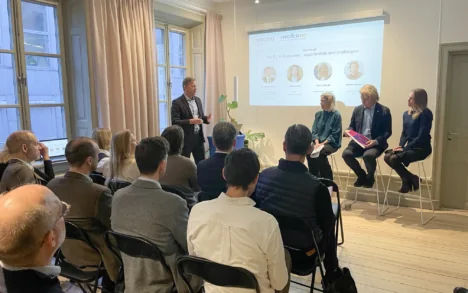With just months to go before the EU joint clinical assessment (JCA) process takes effect, the focus on what it will mean from a country perspective is intensifying. The JCA is integral to the EU health technology assessment (HTA) regulation with the objective of establishing a collaborative approach to evaluating clinical evidence of new treatments among EU member states.[1]
The JCA process will begin in January 2025 with new active substances to treat cancer and advanced therapy medicinal products (ATMPs)[2].
During the Brain and Breakfast discussion in Finland, panelists discussed the JCA’s implications for biopharmaceutical companies of all sizes in the country, as well as the perspective of the pharmaceuticals pricing board or health technology assessment (HTA) organization, HILA.
As with previous panel discussions in the Nordics, the discussion was lively and productive, with widespread commitment to collaboration and open, transparent dialogue. Panelists included a representative from a large pharmaceutical company, someone from a smaller biopharmaceutical company and a representative from HILA. Both companies involved in the discussion have products that will be subject to the JCA process implemented in January 2025. The session was moderated by Herbert Altmann, PhD, VP, Market Access & Healthcare Consulting Europe, at PharmaLex.
Topics explored included:
- The PICO (Population, Intervention, Comparator, and Outcome) scoping process and how companies will align with the diverse requirements of member states and HILA’s expectations
- What companies are doing at the local level to prepare for the JCA
- How the scattered assessment environment in Finland, where separate authorities evaluate different classes of products, will be handled in future and the collaboration between these authorities
Preparing for the PICO
One area of particular concern for Finland-based affiliates is how to accurately predict the PICO scoping process and align with the requirements. As the panelists pointed out, with a diverse treatment environment across the EU, one key challenge will be how to coordinate the PICO process. This is made more challenging by the fact that each member state has only two weeks to respond to the scoping survey[3].
Companies will need to be proactive with gathering insights from national experts, including oncologists and patient organizations, one of the panelists said. Another panelist echoed these concerns, adding that a complication for companies is whether they can be sure they have the right information. “A scoping mechanism for Finland is needed, and companies can help HILA with this,” the panelist noted.
During the discussion, Herbert clarified that an assessor will be assigned and will ask all Member States to give feedback on which PICO will be included for the specific product to be used for the evaluation.
However, the concern is that after the centralized evaluation and publishing the HTA report, HILA may request additional information or data to the PICO, which could slow the national HTA process.
One member of the audience raised concerns as to what will happen if the company has a different perspective on the nationally needed PICO to HILA, since currently there isn’t any dialogue between the companies and the HTA body before submission. Companies are eager to have greater dialogue to help address any potential delay to the process.
Working at a local level
During the discussion, panelists shared how they are preparing for the JCA and the role Finnish affiliates will play in creating the JCA documentation.
The panelist from the larger pharmaceutical company noted that they are preparing and are collaborating with the global, Europe-based headquarters. The JCA will be handled centrally with some local input.
The challenge for smaller companies is that preparation for the JCA is an additional requirement, but there aren’t necessarily more resources to support these activities. Therefore, smaller companies may have a higher risk of not being prepared in time to fulfill the new EU HTAR requirements. With this in mind, having greater collaboration across different Nordic countries would help to reduce the burden, especially for small and mid-size companies, while ensuring the Nordic region is well represented in the process.
For its part, the HILA representative noted that the agency is well prepared but is awaiting the final legislation as well as additional resources to support the JCA processes—a feedback process that is very similar to other HTA bodies across Europe.
One issue that was raised is how to ensure Finland remains competitive within the EU. In our experience, the Nordic countries have generally been regarded as first or at least second-tier countries in an EU launch sequence. A concern raised is that any delay in the national assessment phase could affect the position in a product launch phase, and therefore impact when patients in Finland get access to treatments.
Herbert noted during the discussion that Finland, and the Nordics in general, have key selling points that could be highlighted to keep the region front and center. These include unique opportunities to make use of real-world data and biobanks for real-world evidence purposes, such as through Finland’s Fingenious Service[4]. This includes the flexibility in methodological approaches and the leverage of digital innovation in future methods.
Finland’s diverse assessment process
One issue that complicates the JCA process in Finland is that there are separate authorities for different product classes, with outpatient products managed by HILA and hospital products handled either by Fimea and the Council for Choices in Healthcare (Cohere Finland) when these are high-cost products[5], or by the regions for less expensive products.
PICO scoping
Companies pointed out that after the JCA report is published it should be clear who will assess the product in national level. At the moment, there are different processes if there is a company-initiated application or if the authority decides to start an evaluation. Companies asked for clarification on this.
Companies are eager to see more alignment to address this diverse environment with the PICO scoping and national assessment phase, though questions still remain as to how this will be handled in future. HILA has said that the authorities will work out the PICO scoping, noting that there is a national working group investigating how to harmonize the evaluation processes and adding that it hopes there will only be one responsible authority in future, which would simplify coordination and generate clarity for pharmaceutical and biotech manufacturers.
A productive discussion
While questions and concerns about the JCA process and what it will mean for companies and affiliates in Finland remain, there were many positive takeaways from the panel discussion. It is clear that companies and the authorities are committed to collaborating in order to address concerns about the JCA in general, and the PICO scoping process in particular, to achieve the best outcome for patients in Finland.
This patient-centric approach will support the European Commission’s objective to bring innovative medicines to patients more rapidly while reducing bureaucracy and optimizing the quality of HTA assessments across Europe.
[1] Regulation on Health Technology Assessment, European Commission. https://health.ec.europa.eu/health-technology-assessment/regulation-health-technology-assessment_en
[2] Joint clinical assessment of medicinal products: Submission of early information by
health technology developers, European Commission. https://health.ec.europa.eu/document/download/77476507-9ddc-47e3-ae0d-11c05f89169c_en?filename=hta_%20mp-jca_htd_en.pdf
[3] Scoping process, eunethta 21. https://www.eunethta.eu/wp-content/uploads/2022/09/EUnetHTA-21-D4.2-practical-guideline-on-scoping-process-v1.0.pdf
[4] Access Finnish biobanks via Fingenious, https://site.fingenious.fi/en/all-partner-biobanks








